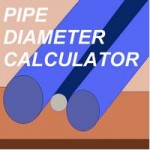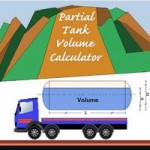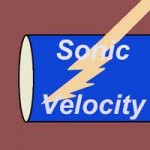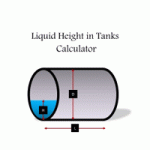Mobile applications below are all available through Google play store

Linear interpolation is a useful technique for estimating values between known data points. When you need to interpolate values from steam tables or other tabulated data.
This application calculates the partial volume and total volume of a tank. It’s designed for horizontal cylindrical vessels. Input requirements include liquid height, tank internal diameter, and cylindrical length. Accepted input units are inch, m, mm, and ft. The application supports various head types: flat heads, ASME F&D (dished) heads, elliptical 2:1 heads, and hemispherical heads. Output results can be displayed in 13 different units.
The Heat Duty Calculator calculates heat transfer rates for both sensible and latent heat transfer. You can specify the flow rate as volumetric or mass flow rate. Density input is required when the flow rate is specified by volume. The calculator supports SI Units and English (US) units. Flow rate input units include m³/s, m³/h, m³/day, ft³/s, ft³/h, ft³/day, kg/s, kg/h, kg/day, lb/s, lb/h, and lb/day.
The Gas Sonic Velocity Calculator calculates the sonic velocity of a specified gas flowing in a pipe. Sonic velocity, also known as the speed of sound, represents the maximum velocity achievable by the gas within the system. This calculator primarily targets process and chemical engineers, providing a convenient tool for quick check calculations. Additionally, it includes a small database with specific heat ratios and molecular weights for 51 gases, aiding in reference.
The MMScfd Converter converts flow rates from 29 different measurement units to Million Metric Standard Cubic Feet per Day (MMScfd). MMScfd is commonly used for natural gas, LPG, and extracted gases in the oil and gas industry. You can input parameters such as operating pressure, operating temperature, standard pressure, and standard temperature to calculate the converted flow rate. The converter supports both conversion from and to MMScfd.
The Liquid Height in Tanks Calculator allows you to determine the liquid height in a horizontal cylinder. It supports various cylindrical ends, including flat ends, ASME F&D (dished ends), elliptical ends, and hemispherical ends. Input parameters include volume of liquid, length of the tank/vessel, and diameter of the tank/vessel. The calculated liquid height is displayed in units such as meters (m), millimeters (mm), inches, or feet (ft).
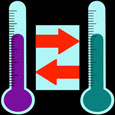
Use the Temperature Converter to switch between 8 different temperature scales. Available units include degrees Celsius, Kelvin, Fahrenheit, Rankine, Delisle, Newton, and Réaumur.

The Antoine Equation calculates fluid vapor pressure using parameters, with options to find vapor pressure at a specified temperature or calculate temperature based on vapor pressure.

The Cavitation coefficient, crucial for fluid flow in centrifugal pumps, is calculated using a specific equation in this application.
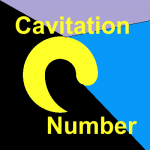
The Cavitation Number (Ca) characterizes the potential for flow cavitation. This app calculates the Cavitation Number and allows back-calculation of related variables (local pressure, fluid vapor pressure, and fluid velocity). Input units include pressure (Pa, kPa, bar, psi, lb/ft²) and velocity (m/s, ft/s). The output is dimensionless by default, but can be specified in various units.

The Pipe Friction Factor Calculator computes the Darcy friction factor, commonly obtained from the Moody chart, and the Fanning friction factor. Input Reynolds’ Number, Pipe Diameter, and Pipe Surface Roughness. Output includes Relative Roughness, Darcy Friction Factor, and Fanning Friction Factor. Choose between the Churchill Equation and Colebrook-White Equation. The app accepts SI and US units and provides material data for various pipe materials.
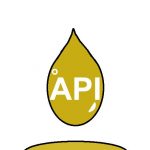
The API gravity measures the weight of petroleum compared to water. This app performs operations like calculating API gravity from liquid density or specific gravity, finding specific gravity from API gravity, determining barrels of crude oil per metric ton, and classifying oil based on API gravity

This mobile app calculates particle wavelength using the de Broglie equation. It also computes velocity or mass based on the same equation. Input units include mass (kg) and velocity (m/s). Output displays wavelength in meters (m), centimeters (cm), nanometers (nm), and angstroms. Velocity output includes meters per second (m/s), meters per minute (m/min), and centimeters per second (cm/s). Mass output is in kilograms (kg), grams (g), and milligrams (mg).

Erosional velocity is the maximum fluid velocity in pipes to prevent excessive erosion. This app estimates erosional velocity using API RP 14E equations, but keep in mind that different operators may have their own guidelines.
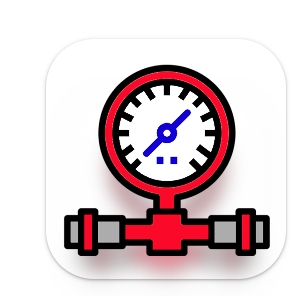
You can convert between 41 pressure units using the Pressure Units Converter app1. It’s simple to use—just select the unit and enter the number you want to convert. Plus, it works offline.

ound Effects App: Enjoy over 1100 realistic sounds across 25 categories. Play, save favorites, and even create custom sound sequences. Download sound files directly to your phone.
More Apps Coming Soon….

Keep an eye for more apps coming soon!..
System Requirements:
All our Apps needs Android 4+ and above. Please see each app for more specifications.
Please Contact us for any further information.

